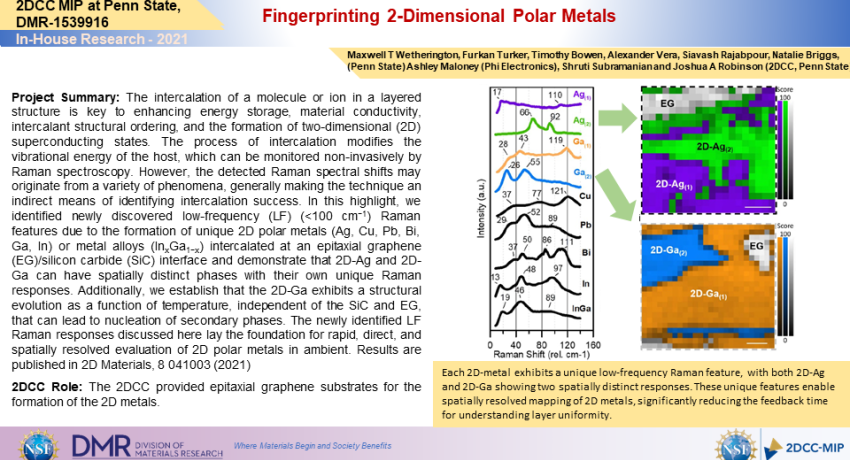Project Summary: The intercalation of a molecule or ion in a layered structure is key to enhancing energy storage, material conductivity, intercalant structural ordering, and the formation of two-dimensional (2D) superconducting states. The process of intercalation modifies the vibrational energy of the host, which can be monitored non-invasively by Raman spectroscopy. However, the detected Raman spectral shifts may originate from a variety of phenomena, generally making the technique an indirect means of identifying intercalation success. In this highlight, we identified newly discovered low-frequency (LF) (<100 cm−1) Raman features due to the formation of unique 2D polar metals (Ag, Cu, Pb, Bi, Ga, In) or metal alloys (InxGa1−x) intercalated at an epitaxial graphene (EG)/silicon carbide (SiC) interface and demonstrate that 2D-Ag and 2D-Ga can have spatially distinct phases with their own unique Raman responses. Additionally, we establish that the 2D-Ga exhibits a structural evolution as a function of temperature, independent of the SiC and EG, that can lead to nucleation of secondary phases. The newly identified LF Raman responses discussed here lay the foundation for rapid, direct, and spatially resolved evaluation of 2D polar metals in ambient. Results are published in 2D Materials, 8 041003 (2021)
2DCC Role: The 2DCC provided epitaxial graphene substrates for the formation of the 2D metals.
What Has Been Achieved: A facile route for characterizing 2D metals.
Importance of the Achievement: This work provides the first reported ability to rapidly identify the presence of 2D metals.
Unique Feature(s) of the MIP that Enabled this Achievement: large area epitaxial graphene
(If Applicable) Publication: Maxwell T Wetherington et al 2021 2D Mater. 8 041003
Acknowledgements: This work was supported in part by Horiba Scientific, the Air Force Office of Scientific Research (FA9550-19-1-0295), the National Science Foundation (NSF) under DMR-2002651 and DMR-2011839 through the Penn State MRSEC−Center for Nanoscale Science, the 2D Crystal Consortium NSF Materials Innovation Platform under cooperative agreement DMR-1539916. We thank Horiba application scientists David Tuschel, Fran Adar, Bridget O'Donnell and Sergey Mamedov, the staff within the Materials Characterization Laboratory in the Materials Research Institute at The Pennsylvania State University, John Newman and Ben Schmidt from Physical Electronics for measurement assistance and fruitful discussions.
